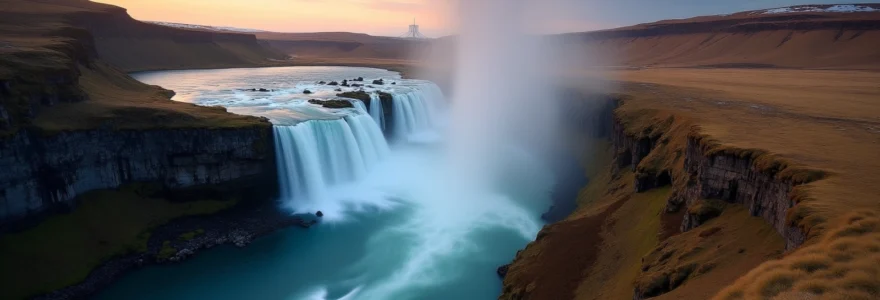Photography enthusiasts are always on the lookout for breathtaking locations that offer unique opportunities to capture stunning images. From iconic landscapes to bustling urban scenes, the world is brimming with photographic potential. This comprehensive guide explores ten must-visit destinations that promise to ignite your creativity and elevate your photography skills. Whether you’re drawn to natural wonders, architectural marvels, or wildlife encounters, these locations offer something truly special for every type of photographer.
Iconic landscape vistas: from yosemite to santorini
Landscape photography allows artists to capture the raw beauty of nature in its most magnificent forms. Three locations stand out as particularly captivating for those seeking to immortalise natural wonders through their lenses.
Capturing yosemite’s el capitan at golden hour
Yosemite National Park in California is a paradise for landscape photographers, with El Capitan serving as its crown jewel. This massive granite monolith rises nearly 3,000 feet from the valley floor, creating a dramatic backdrop for photography. The golden hour, occurring just after sunrise or before sunset, bathes El Capitan in a warm, ethereal light that can transform an ordinary shot into something truly extraordinary.
To capture the perfect image of El Capitan, consider these tips:
- Use a wide-angle lens to encompass the sheer scale of the formation
- Experiment with long exposures to add movement to clouds or water features
- Include foreground elements like trees or rocks for depth and perspective
Santorini’s Blue-Domed churches: composition techniques
The Greek island of Santorini is renowned for its picturesque white-washed buildings topped with vibrant blue domes. These iconic structures, set against the backdrop of the Aegean Sea, offer endless possibilities for creative composition. Mastering the art of framing is crucial when photographing Santorini’s churches.
Consider these composition techniques to enhance your Santorini shots:
- Use leading lines from staircases or pathways to guide the viewer’s eye
- Incorporate the natural curves of the domes to create dynamic shapes within the frame
- Experiment with different times of day to capture the interplay of light and shadow on the white surfaces
Mastering long exposures at iceland’s skógafoss
Iceland’s Skógafoss waterfall presents an ideal opportunity to practice long exposure photography. The powerful cascade, dropping 60 meters, creates a mesmerising curtain of water that can be rendered silky smooth with the right technique. Achieving the perfect long exposure requires patience and the right equipment.
Essential gear and settings for capturing Skógafoss include:
- A sturdy tripod to eliminate camera shake during long exposures
- Neutral density filters to reduce light and allow for longer shutter speeds
- Shutter speeds ranging from 1 to 30 seconds, depending on the desired effect
Urban photography hotspots: architecture and street scenes
Urban environments offer a rich tapestry of photographic subjects, from iconic landmarks to the vibrant energy of city life. Three cities stand out as particularly rewarding destinations for urban photography enthusiasts.
Framing the eiffel tower: beyond cliché shots
The Eiffel Tower in Paris is one of the most photographed structures in the world, presenting a challenge for photographers seeking unique perspectives. To capture this iconic landmark in a fresh way, consider exploring less conventional vantage points or incorporating unusual foreground elements.
Innovative approaches to photographing the Eiffel Tower include:
- Using reflections in puddles or glass surfaces to create abstract compositions
- Incorporating street scenes or local Parisians to add context and scale
- Experimenting with nighttime photography to capture the tower’s illumination
New york’s brooklyn bridge: Low-Light photography challenges
The Brooklyn Bridge offers a quintessential New York City photography experience, especially challenging and rewarding during low-light conditions. Mastering low-light techniques is crucial for capturing the bridge’s iconic structure and the city skyline beyond.
Key considerations for low-light photography at the Brooklyn Bridge include:
- Using a high ISO setting balanced with noise reduction techniques
- Opting for a wide aperture lens to maximise light gathering
- Experimenting with long exposures to capture light trails from passing vehicles
Tokyo’s shibuya crossing: capturing urban energy
Shibuya Crossing in Tokyo is often described as the world’s busiest pedestrian crossing, offering a unique opportunity to capture the pulsating energy of urban life. The challenge lies in conveying the sense of movement and the sheer scale of the human tide that floods the intersection with each light change.
Techniques for photographing Shibuya Crossing effectively include:
- Using a slightly elevated vantage point to show the full expanse of the crossing
- Experimenting with slow shutter speeds to create a sense of motion blur
- Focusing on individual subjects within the crowd to tell more personal stories
Wildlife photography destinations: from arctic to equator
Wildlife photography presents unique challenges and rewards, requiring patience, quick reflexes, and often specialised equipment. Three destinations stand out for their exceptional wildlife photography opportunities.
Svalbard’s polar bears: telephoto lens techniques
The remote Norwegian archipelago of Svalbard offers rare opportunities to photograph polar bears in their natural habitat. Mastering telephoto lens techniques is crucial for capturing these magnificent creatures safely and ethically.
Key considerations for polar bear photography in Svalbard include:
- Using a lens with a focal length of at least 400mm to maintain a safe distance
- Employing image stabilisation techniques to counteract camera shake
- Being prepared for extreme cold with appropriate gear protection
Masai mara’s great migration: action shot strategies
Kenya’s Masai Mara National Reserve is famous for the annual Great Migration, offering unparalleled opportunities for action wildlife photography. Capturing the drama of wildebeest crossing rivers or evading predators requires quick thinking and precise timing.
Strategies for successful action shots in the Masai Mara include:
- Using continuous autofocus and burst mode to capture split-second moments
- Anticipating animal behaviour to be ready for key moments
- Considering the background and lighting to create more impactful images
Galapagos islands: underwater photography essentials
The Galapagos Islands offer a unique blend of terrestrial and marine wildlife photography opportunities. Underwater photography in the Galapagos presents its own set of challenges and rewards, allowing photographers to capture the rich marine life of this UNESCO World Heritage site.
Essential considerations for underwater photography in the Galapagos include:
- Investing in a quality underwater housing for your camera
- Using wide-angle lenses to capture the expansive underwater landscapes
- Learning to work with natural light and strobe lighting techniques
Cultural heritage sites: preserving history through the lens
Cultural heritage sites offer photographers the opportunity to capture the essence of human history and achievement. These locations present unique challenges in balancing architectural detail with the spirit of the place.
Machu picchu: balancing natural light and ancient architecture
Peru’s Machu Picchu is a testament to Incan ingenuity, set against a backdrop of stunning mountain scenery. Photographing this site requires a delicate balance between capturing the intricate stonework and conveying the majesty of its setting.
Tips for photographing Machu Picchu include:
- Arriving early to capture the site bathed in the soft light of dawn
- Using a polarising filter to enhance the contrast between stone and sky
- Incorporating the surrounding mountains to show the site’s context
Angkor wat: HDR techniques for temple interiors
Cambodia’s Angkor Wat complex presents a challenge in capturing both the intricate details of its stone carvings and the overall grandeur of its architecture. High Dynamic Range (HDR) photography can be particularly effective in balancing the extreme contrasts often encountered in temple interiors.
Key considerations for HDR photography at Angkor Wat include:
- Bracketing exposures to capture a wide range of light levels
- Using a tripod to ensure perfect alignment between exposures
- Applying HDR techniques judiciously to maintain a natural look
Petra: capturing the treasury in changing light conditions
Jordan’s ancient city of Petra, with its iconic Treasury facade, offers photographers a chance to explore how changing light can transform a subject throughout the day. The narrow Siq leading to the Treasury creates unique lighting challenges and opportunities.
Strategies for capturing Petra’s Treasury include:
- Visiting at different times of day to capture varied lighting conditions
- Using the Siq’s walls to frame the Treasury as it comes into view
- Experimenting with long exposures to capture the movement of people or clouds
Abstract landscapes: nature’s patterns and textures
Abstract landscape photography allows artists to explore the intricate patterns and textures found in nature, often revealing perspectives that are not immediately apparent to the casual observer.
Namibia’s sossusvlei: aerial photography of sand dunes
The towering sand dunes of Namibia’s Sossusvlei offer a unique canvas for abstract landscape photography, particularly when viewed from above. Aerial photography techniques can reveal the striking patterns and interplay of light and shadow across the dunes.
Considerations for aerial photography in Sossusvlei include:
- Using a drone or light aircraft to gain a bird’s-eye perspective
- Focusing on the interplay of light and shadow to create dynamic compositions
- Experimenting with different times of day to capture changing colours and textures
Yellowstone’s grand prismatic spring: colour theory in practice
The Grand Prismatic Spring in Yellowstone National Park is a natural wonder that seems almost too vibrant to be real. Its kaleidoscope of colours offers photographers a unique opportunity to explore colour theory in a natural setting.
Tips for capturing the Grand Prismatic Spring include:
- Using an elevated vantage point to capture the full circular shape of the spring
- Employing a polarising filter to reduce glare and enhance colours
- Considering the interplay between the spring’s colours and the surrounding landscape
Antelope canyon: mastering slot canyon light challenges
Arizona’s Antelope Canyon presents photographers with the challenge of capturing the interplay of light and shadow in a narrow slot canyon. The way sunlight filters into the canyon creates ever-changing patterns and textures on the sandstone walls.
Techniques for photographing Antelope Canyon include:
- Using a tripod to allow for longer exposures in low light conditions
- Experimenting with different white balance settings to capture the true colours of the rock
- Looking for abstract compositions in the curves and textures of the canyon walls
Each of these destinations offers unique challenges and opportunities for photographers to hone their skills and capture truly remarkable images. By mastering the specific techniques required for each location, you can create a portfolio that not only showcases the beauty of these places but also demonstrates your growth as a photographer. Remember, the key to successful travel photography lies not just in the technical aspects of image-making, but also in your ability to connect with and interpret the essence of each unique location.


